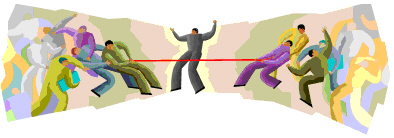A project leader recently asked me how to promote cooperation among members of his virtual team who are at different locations. This is a common issue that virtual team leaders struggle with. Virtual teams often consist of subgroups of team members located in separate locations. This division of team members can give rise to social categorization within the team (i.e., those who are located here versus those who are not), which creates potential for conflict and mistrust within the team (see here).
In this post I cover:
- Locations giving rise to subgroups and negative effects in virtual teams,
- Ethnorelativism as a way to counter the negative effects, and
- How to develop ethnorelativism.
I based the post largely on the work of Cramton & Hinds.
Locations giving rise to subgroups
Locations may differ in terms of national and work culture, team members’ education levels, and other demographic features, often resulting in differences in interpretation of issues and the interests of team members. Locations may also differ in terms of physical settings and constraints. For instance, buildings and equipment may be different as may the distances to work and traffic conditions. Holiday observances, shopping hours, and even typical workday hours may be different. These dissimilarities may lead to differing assumptions and preferences about work. For instance, members in locations with heavy traffic or high gasoline prices might prefer to coordinate their schedules with that of the public transportation system and resist office trips or staying in office at odd hours. Similarly, those in areas with poor Internet connectivity for residential users might resist the requirement of logging into their system for updates at odd hours.
While members in one location might notice a certain pattern of assumptions, preferences, or constraints exhibited by their colleagues elsewhere, they may not fully grasp or appreciate this pattern. Lack of appreciation of cultural differences, assumptions, preferences, and constraints creates a potential for conflict. Members notice behaviors of others like resistance or difference in habits; without enough information they might make attributions that are incorrect and damaging to the group.
Countering negative effects with ethnorelativism
How do we counter this destructive subgrouping and promote cooperation? By being ethnorelativistic. Being ethnorelativistic means taking the perspectives of and understanding the world through the eyes of the other subgroups. It involves adapting one’s behaviors to be appropriate in the contexts of other subgroups. Simply following tips or rules is not going to be sufficient. One has to feel natural or right in the contexts of other subgroups. One has to expand one’s perspective and show empathy to others. Of course, the more subgroups there are, the more challenging it will be for any subgroup to be ethnorelativistic.
How to develop ethnorelativism?
Based on the research of Cramton & Hinds, the following measures can be taken to develop ethnorelativism.
- Create cooperative interdependence
Make subgroups strive for a common goal – the success of any subgroup should be tied to the success on one common goal. This motivates them to learn about each other and work with each other cooperatively.
- Create equal status among subgroups
Subgroups are more likely to develop ethnorelativism when they perceive other subgroups to be of equal status. When the status is equal, the subgroups are more likely to engage each other in discussions about their differences. If these discussions are managed properly, with an open mind to accept rather than resolve differences, then ethnorelativism can develop.
- Provide institutional support for subgroup contact
Subgroups are more likely to engage each other and learn about their differences to the extent there is institutional or top management support for such engagement. Certain companies have norms that support the expression of differences (e.g., customs of different regions to which the subgroups belong are showcased).
- Enable explicit sharing of information within the team
During the creation of rules of engagement (a part of the team compact), it will be useful to ask team members to list the preferences they have and the constraints they face to accomplish their work (e.g., constraints related to technology, physical space, working hours, holiday observances, etc.). Also ask them to list aspects of culture that influence how they interact with others. Make sure that these constraints and cultural aspects are considered when creating the rules of engagement. Some of this information sharing will take place on an ongoing basis. During discussions, ask subgroups to provide the reasons behind their decisions so that all the subgroups are aware of what is guiding decision making in other subgroups.
Another aspect of explicit sharing of information is to engage in inclusive communication, i.e., not engage in communication in which one or more subgroups are left out. This may not be possible for all synchronous or real-time meetings if the subgroups are distributed across distant time zones but attempts to share minutes of such meetings with all subgroups can reduce the feeling that one has been left out.
See a recent post by Betsy on “Fostering Ambient Awareness in Virtual Teams” for additional tips on enabling explicit sharing of information.
Location-based subgroups in virtual teams can create challenges for a virtual team leader. By using the measures that I have described to develop enthorelativism within the team, the leader can deal with these challenges effectively.


? used to be a?le to find good ad?ice fr?m youir blog posts.